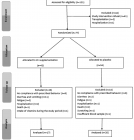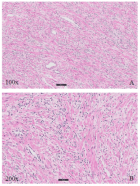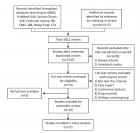About Gazi University
Gazi University
Articles by Gazi University
Cytomegalovirus pneumonia and Cryptogenic organizing pneumonia following pediatric stem cell transplantation for leukemia
Published on: 12th September, 2017
OCLC Number/Unique Identifier: 7355939062
Background: Knowledge of pulmonary complications (PCs) in children after hematopoetic stem cell transplantation (allo-HSCT) is limited; most data are from adult studies.
Case: We describe a 8 year old girl with high risk acute myeloid leukemia who developed graft versus host disease (GVHD) on Day 20, Cytomegalovirus (CMV) pneumonia on Day 50 and Cryptogenic organizing pneumonia (COP) on Day 170 after allo-HSCT.
Discussion: Cryptogenic organizing pneumonia is a rare noninfectious PCs that can be idiopathic or have several risk factors as a secondary causes, such as viral respiratory infections, drugs, GVHD and allo-HSCT. Viral respiratory infections and alloimmune lung syndromes have been reported in a few patients who have undergone transplantation.
Conclusion: Transplant physicians should be kept in mind for the development of alloimmune lung syndrome in the form of COP following CMV pneumonia in patients after allo- HSCT
Predictive Psychological Factors of Problematic Alcohol use in University Students
Published on: 30th January, 2017
OCLC Number/Unique Identifier: 7317646409
The objective of this study is to determine prevalence of alcohol-substance use among university students, and to investigate the correlation between the childhood abuse, suicide probability and anger expression styles in students who have drinking problems. A survey was carried out among randomly selected students from the Faculty of Education in Baskent University in Turkey. Study sample consists of 399 university students. Childhood Trauma Questionnaire (CTQ), Trait Anger and Anger Expressions Scales (T-Anger-Anger EX), and Suicide Probability Scale (SPS) were used. The CAGE questionnaire was applied to identify the problems of alcohol use. Probable presence of an alcohol use disorder is indicated by a score of 1+, whereas a score of 2+ was taken as the cut-off point for assessing presence of clinically significant alcohol use problems. Data were analyzed using with t test and multiple binary logistic regression. Of the whole sample 36.9% reported that they had ever tried drinking alcohol. The overall prevalence of alcohol use problems according to CAGE 1+ was 14.4% and CAGE 2+ was 7.3%. Sexual abuse and Anger-In were predictors of CAGE 1+, suicide probability was predictor of CAGE2+. Childhood trauma experiences especially, sexual abuse, suicide probability, trait anger, the anger expressed inside and outside were main factors to identify alcohol use problems. Professionals and parents must pay attention to childhood traumatic experiences, suicide and anger expression styles in youths with alcohol use problems.
Determination of calcium in the tooth structure by using flame emission spectrophotometer
Published on: 15th May, 2020
OCLC Number/Unique Identifier: 8595799073
Calcium is the most common element in the tooth’s structure. In addition, calcium is one of the elements that are effective in maintaining dental health. As a result of calcium deficiency, the tooth becomes brittle and begins to rot. Calcium deficiency usually occurs in acidic beverage consumption and during canal treatment. A study was conducted to determine the degree of calcium removal in the root canal dentin after 17% EDTA, 17% EGTA, 15% EDTAC and 1% tetracycline-HCl treatment; later with or without 2.5% NaOCl [1]. Extracted single-rooted human teeth were bisected longitudinally and the root halves (n = 100) were isolated with nail varnish, leaving the root canal exposed. The samples were immersed in the test solutions for 1 and 5 minutes, after which the amount of calcium ion (Ca2+) release into the solutions was determined by flame photometry.
The calcium ions (Ca2+) present in hydroxyapatite crystals are one of the main inorganic elements of dentin [2]. It has been reported that some chemicals used for endodontic irrigation are capable of causing alterations in the chemical composition of dentin [3-6].
MethodsDetermination of calcium in the tooth’s structure is very important. Calcium determination, Flame Emission Spectrofometry and inductively coupled plasma optical emission spectrometry (ICP-OES) methods can be performed. These methods can be analyzed in a short time without interference effects. In both methods, the calcium in the tooth is stimulated and the emission intensity it emits is measured as it becomes basic. These emission intensities are directly proportional to the calcium concentration. Also, in these methods, calibration graph or standard addition method is used for calcium determination.
The roots were then bisected longitudinally, and the pulp tissue was removed with a toothbrush. All root halves (n = 100) were dehydrated in a sterilizer at 120 °C until they reached a fixed weight, as verified by consistent readings using a precision scale (Sartorius, Gotingen, Germany; precision = 0.0001 g). Thereafter, the specimens were covered with two consecutive layers of nail varnish, leaving the root canal surface exposed.
The samples were randomly distributed into the following treatment.
Groups:
Group 1: 2.5% NaOCl
Group 2: 17% EDTA
Group 3: 17% EGTA
Group 4: 15% EDTAC
Group 5: 1% Tetracycline-HCl
Group 6: 17% EDTA _ 2.5% NaOCl
Group 7: 17% EGTA _ 2.5% NaOCl
Group 8: 15% EDTAC _ 2.5% NaOCl
Group 9: 1% Tetracycline-HCl _ 2.5% NaOCl
Group 10: Distilled water (negative control)
In each group, the specimens were immersed in a magnetic stirrer bath containing 10 ml of test solution for 1 and 5 minutes. In groups 1 and 10, the same samples (n = 10) were used for 1- and 5-minute treatments.
Calcium is measured between 10 and 1000 ppm (mg/L) with Flame emission intensity. Calcium at a lower concentration cannot be measured.
Inductively coupled plasma optical emission spectrometry (ICP-OES) is a widely used method recently. ICP-OES is an advanced high-end method of flame emission spectrophotometer. In this method, the energy source required for excitation is provided by plasma and its temperature is between 4000 and 10000 ⁰C. There is a certain wavelength of light to which each element is stimulated. The wavelength of the light used for calcium is 455,531 nm. At this wavelength, a calibration graph is prepared from standard solutions of calcium. Calcium in the tooth is measured using the calibration chart.
The sensitivity of this method is high. Calcium analysis in ppm (mg/L) and ppb (µg/L) concentration can be analyzed with ICP-OES. In this method, the analysis takes minutes. Therefore, it is used in routine analysis.
ConclusionUsing these methods, you can easily analyze the calcium found in the structure of the tooth. Also, disinfectant like hypochlorite used during canal treatment increases the calcium release of the tooth. Therefore, the released calcium can also be analyzed using these methods. Here, each sample takes at least 5 measurements and gives the results in accordance with the scientific representation.
Burnout and Related Factors in Caregivers of outpatients with Schizophrenia
Published on: 9th March, 2017
OCLC Number/Unique Identifier: 7317652087
Objectives: Care of a person with schizophrenia involves multiple problems, possibly leading to burnout which is a culturally influenced phenomenon. The aim of this study was to investigate burnout and related factors in caregivers of outpatients with schizophrenia.
Methods: Subjects included in the study were 40 primary caregivers of outpatients with schizophrenia (15 males, 25 females) whom were assessed with the Maslach Burnout Inventory (MBI), the Beck Depression Inventory (BDI) and the Beck Anxiety Inventory (BAI). Patients were also administered the Calgary Depression Scale (CDS). Also, sociodemographic information about patients and their caregivers were taken. The significance of differences between two groups was determined by Mann-Whitney U-test. The relationships between the variables were evaluated by Pearson correlation analysis.
Results: No significant difference was found in the MBI subscale scores in terms of caregivers gender, marital status, and education, being a family member, having enough information about the illness and taking support during caregiving. Emotional Exhaustion and Personal Accomplishment subscale scores of the caregivers were significantly different in terms of patients’ adaptation to treatment or not (respectively; p=0.010, p=0.030). The MBI-Emotional Exhaustion scores revealed significant positive correlations with the BDI and BAI total scores. Also, the MBI- Depersonalization scores and the BAI scores were positively correlated.
Conclusions: Burnout levels in caregivers of patients with schizophrenia were lower when compared with other cultures. Only treatment compliance predicted burnout, while other factors were excluded. Therefore, professionals have to help to patients primarily adapt to their treatment.
Laparoscopic surgical treatment of median arcuate ligament syndrome with the retrograde division technique: a case report
Published on: 18th May, 2022
Median arcuate ligament syndrome is a rare entity. This clinical condition develops by compression of the root of a celiac artery with the median arcuate ligament. The typical triad of this syndrome is the following; abdominal discomfort and pain, especially after a meal, and weight loss. In diagnosis, other causes should be ruled out and compression must be demonstrated by any type of imaging method. The main principle of treatment is cutting down the median arcuate ligament. A 54-year-old woman presented with untreatable recurrent abdominal pain and was diagnosed with median arcuate ligament syndrome by imaging with angiographic computed tomography. This patient was operated on. We performed laparoscopic division of median arcuate ligament with the retrograde surgical dissection technique. The patient was discharged from the hospital without any complaint on the third day after surgery. She was still symptom-free after 12 months.The laparoscopic retrograde dissection approach is a safe and feasible treatment modality for median arcuate ligament syndrome.
Analysis and Comparison of Social Media Applications Using Forensic Software on Mobile Devices
Published on: 22nd October, 2024
With the integration of mobile systems into daily life, social media applications used especially on Android and iOS platforms contain a significant amount of sensitive information. Social media applications on mobile systems have huge personal and sensitive content. Therefore, it is important to design effective techniques for forensic analysis of social media applications and to detect personal data. In this research, three different paid mobile forensic software and 4 different brands and models of smartphones with different operating systems were used and analyzed. The study shows that private messages, e-mails, time information, shared data, location and time information, and other personal data can be obtained by a forensic expert who performs an examination, and it is seen that one software can access the deleted data, but another software cannot access it. In proportion to the technology used in today’s world, mobile forensics incidents are increasing day by day, and a competitive environment is created among the software used to illuminate these incidents. With this competition, software companies dealing with forensic informatics are trying to obtain different data to illuminate forensic events that may occur due to the active use of social media accounts with the developing technology, and software that does not meet the needs in the face of this situation remains in the background. The criminal elements in the investigation areas of mobile forensics differ daily, and the scope of crimes in the virtual environment is expanding with the developing technology. Therefore, mobile forensic analysis applications should be successful in social media applications other than standard data.

HSPI: We're glad you're here. Please click "create a new Query" if you are a new visitor to our website and need further information from us.
If you are already a member of our network and need to keep track of any developments regarding a question you have already submitted, click "take me to my Query."


















































































































































